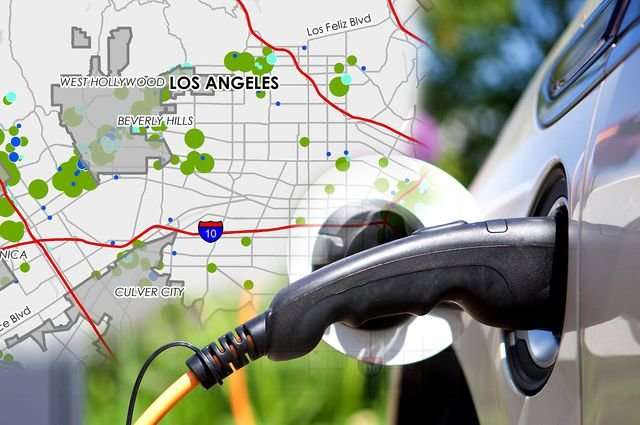More than 700,000 plug-in electric vehicles are expected on Southern California roads by the end of 2025. Credit: University of California, Los Angeles
More than 82,000 electric vehicles were registered in Southern California between 2011 and 2015. The number of new plug-in electric vehicles registered there in 2015 increased a whopping 992 percent from 2011.
Now, a report produced by the UCLA Luskin Center for Innovation forecasts continued exponential growth in the electric vehicle market, with more than 700,000 plug-in electric vehicles expected to hit Southern California roads by the end of 2025.
This forecast assumes that over time more residents of apartments and other multiunit dwellings will be able to charge at home. The report, the Southern California Plug-In Electric Vehicle Readiness Atlas, can help make that happen, according to J.R. DeShazo, director of the Luskin Center for Innovation.
"We wanted to provide a tool that decision-makers can use to accommodate forecasted consumer demand for electric vehicles and charging infrastructure," DeShazo said. For example, the atlas provides planners with critical spatial information for meeting charging demand in multiunit residences and other places. It can also help utilities identify where utility upgrades may be needed to accommodate additional electricity loads.
The atlas documents the concentration of plug-in electric vehicles in a given neighborhood, visualizes how that concentration varies over the course of a day, and projects plug-in electric vehicle growth over the next 10 years for each of the 15 subregional councils of government within Southern California.
With support from the Southern California Association of Governments and the California Energy Commission, the 2017 atlas is an update to the first Southern California Plug-In Electric Vehicle Readiness Plan and Atlas created by the Luskin Center for Innovation in 2013. Recognizing that the plug-in electric vehicle market has changed considerably in the last five years, the updated atlas helps decision-makers plan for future changes.
"Like the region's first PEV plan and atlas, the 2017 update can help open people's eyes to the promises and challenges posed by electric charging stations," said Marco Anderson, a senior regional planner with the association of governments. As a liaison to cities in the region, he has seen how many cities used the first atlas to find local partners for charging station sites.
The new maps include:
- the locations and sizes of workplaces, multiunit residences and retail establishments that could potentially host electric vehicle charging
- the locations of existing charging infrastructure, including the number of charging units/cords and level of service
- and the locations of publicly accessible parking facilities to fill in gaps in electric vehicle charging, particularly in older urban cores.
More information: A downloadable copy of the atlas is available: innovation.luskin.ucla.edu/con … ss-atlas-2017-update
Provided by University of California, Los Angeles






















